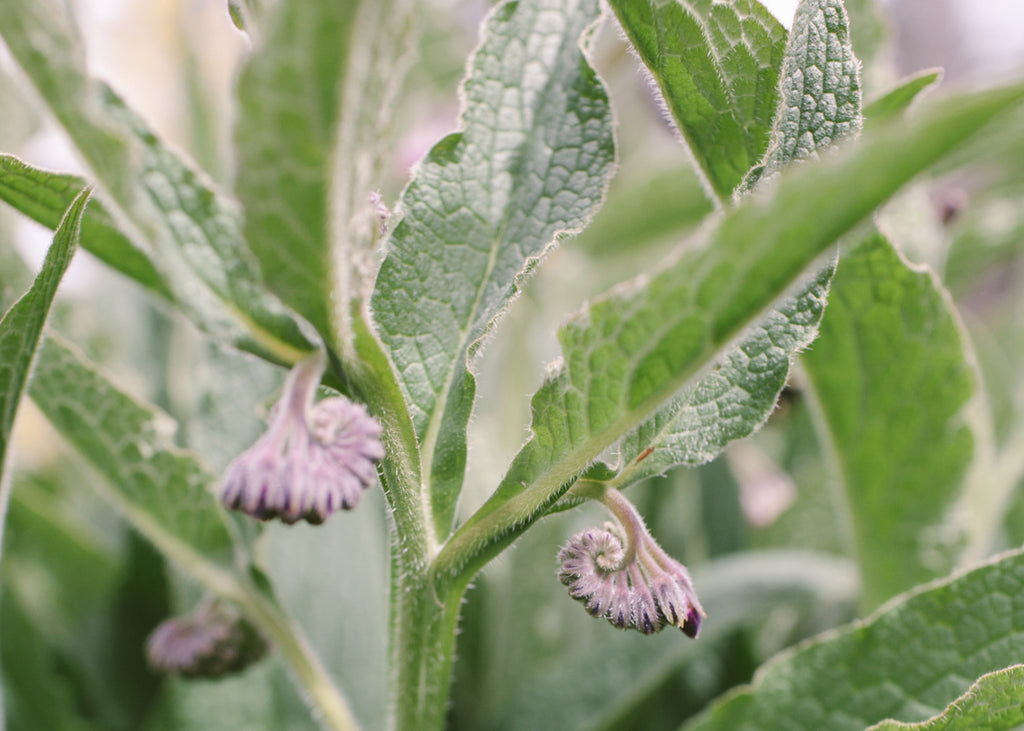There are many plants out there that create a buzz. And not just from the bees. One such plant is Comfrey. It has been heralded as a medicine, food and cover crop since Ancient Greece.
You’ll find this herbaceous perennial speckled throughout our orchards here at Siskiyou Seeds, popping up here and there. Pushing against the paving stones. Comfrey is a member of the Boraginaceae family, the same family as Borage. Borage is a real cutie in the garden with edible purple star-like flowers. Like Borage, Comfrey has downy leaves and hair covered stems. Tall and erect, it will grow to about 3 feet. “Its flowers are dull purple, blue or whitish, and densely arranged in clusters” (1). There are many species of comfrey but the one that interests us most is Russian Comfrey, also known as ‘Quaker Comfrey’
We grow Russian Comfrey here at the Siskiyou Seeds farm because it does not have viable seed. The latin name is Symphytum x uplandicum. A cross popularized by Comfrey researcher Henry Doubleday from England. He originally introduced it as a possible substitute for Gum Arabic. In the 1950’s the strain was exported to America as Quaker Comfrey (2).

Comfrey is best cultivated in root cuttings. This is by far the easiest and cheapest way to grow it. You can easily establish a bed of Comfrey with a handful of cuttings. In a few years you will be able to divide your Comfrey bed and share it with your friends and neighbors. It grows in clumps and spreads rhizomatically and enjoys division just like Iris’ do.
When you receive a Comfrey live root cutting from us or from a friend you can cover it with some potting mix or peat moss until you are ready to plant. It might start growing a little if your medium is damp. The best time to plant Comfrey is in mid to late March depending on your growing zone. If your ground is still frozen in March, plant the root in a pot and then transplant out when the soil is workable. It is fairly easy to get your cutting to grow. Prepare your bed space in whatever method you prefer. Lay your root cutting flat and then cover with soil. It should be a few inches deep. You might want to mark the spot with a stake. Keep the soil fairly damp until the leaves start sprouting. Comfrey is fairly drought tolerant. But it does enjoy nice moist soil.

What do you want Comfrey to do for you? It is important to plan where you want your Comfrey to grow. It can spread rather quickly when given ample space and forms a dense ground covering. Making it excellent at competing with weeds (3). If you are using the leaves as chop or fodder for animals you may want to plant it in your grazing areas. Just make sure to protect the baby plant so it can get established. Considering the hairy leaves are not palatable fresh to all animals you may have to chop the green part of the plant down to feed animals like horses and cows (4). It is planted in the orchards here as weed control. I like to have it on hand for topical herbal remedies. So perhaps you just want a little bit in your home herb garden to use for medicinal needs.
There is controversy about internal uses of Comfrey so I will not get into that here. You know I like to encourage you to do your own research before you start using plants for medicinal purposes. There has been quite a bit of research done into the efficacy of Comfrey most of which occurred in the late 1970’s. It is best to be as informed as you can be about what you use in your body. Comfrey is really lovely in topical applications for healing clean abrasionions. You do not want to use it on deep cuts or wounds that you have not been cleaned yet. If you do add Comfrey to your salves be sure to cut and then dry the root before you infuse it in your oil as it has a high water content.
Whatever your reason for growing Comfrey. It is a lovely addition to your garden.
Gracefully filling in and keeping the soil covered which is an excellent goal.
Happy Planting!
Taryn Hunter
Lead Seed Coordinator, Siskiyou Seeds
References:
1. Comfrey. Mount Sinai Health System. (n.d.). Retrieved January 16, 2023, from https://www.mountsinai.org/health-library/herb/comfrey
2. Robinson, R. G. (n.d.). Comfrey- a controversial crop - university of minnesota. conservancy.unm.edu. Retrieved January 16, 2023, from https://conservancy.umn.edu/bitstream/handle/11299/141442/MR191.pdf
3. Teyner, T.M. et al. “Comfrey”, Alternative Field Crops Manual. Web. 19 Aug 2020
https://hort.purdue.edu/newcrop/afcm/comfrey.html
4. Robinson, R. G. (n.d.). Comfrey- a controversial crop - university of minnesota. conservancy.unm.edu. Retrieved January 16, 2023, from https://conservancy.umn.edu/bitstream/handle/11299/141442/MR191.pdf
~ Written by: Taryn Hunter


Bruce Robinson
In the UK comfrey leaves are used to make comfrey liquid fertilizer. Apparently it smells awful but plants love it. Some just put leaves in a hole with soil and put in plants. What do you think?